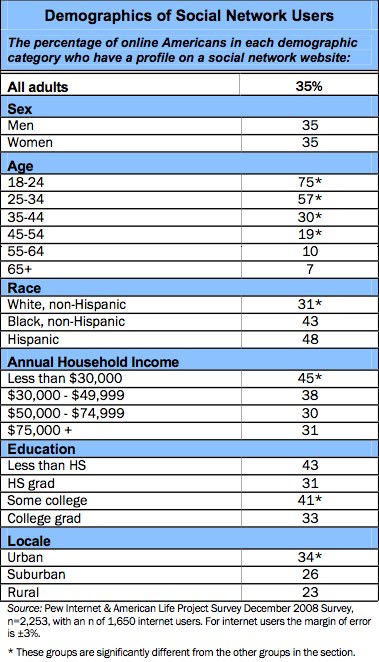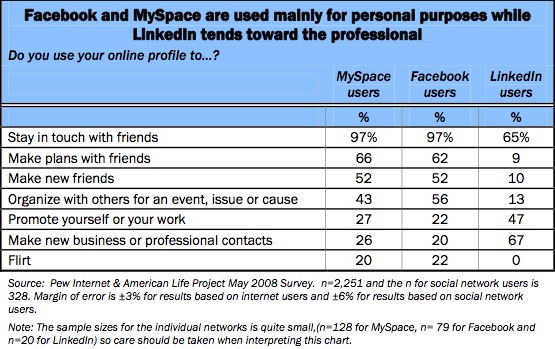(cc) Brian Solis
As Social Media permeates our rhythm and routine for discovering, creating and sharing content and information online, the gap between generations is rapidly diminishing.
PEW Research released a new report that documents the increase in social networking activity among U.S.-based adults for both personal and professional relationships.
Just over one third (35%) of American adult Internet users have created a profile on an online social network, four times as many as three years ago. However, it is still much lower than the 65% of online American teens who use social networks to showcase their personality and also communicate with others.
Prior to reviewing the in-depth findings by PEW, we can assume that:
– LinkedIn caters to an older demographic that is more interested in cultivating professional connections and promoting expertise.
– Facebook, while attracting a broader age group of users, is still highly focused on younger demographics and facilitating personal connections and events.
– MySpace, well, is MySpace, and largely hosts the majority of America’s youth for personal interaction and self-expression/promotion.
According to the study, adults make up a larger portion of the US population than teens, which is why the 35% number represents a larger number of users than the 65% of online teens who
also use online social networks. Still, younger online adults are much more likely than their older counterparts to use social networks, with 75% of adults 18-24 using these networks, compared to just 7% of adults 65 and older. At its core, use of online social networks is still a phenomenon of the young.
Among adults, MySpace is the most popular online social network. 50% of adult social network users age 18 and older are on MySpace, while 22% of adult social network users have an account on Facebook. Another 6% have an account on LinkedIn, 2% have an account on Yahoo, and 1% each have accounts on YouTube and Classmates.com.
PEW Research Observes:
– 75% of online adults 18-24 have a profile on a social network site
– 57% of online adults 25-34 have a profile on a social network
– 30% of online adults 35-44 have one
– 19% of online 45 to 54 year olds have a profile
– 10% of online 55 to 64 year olds have a profile
– 7% of online adults 65 and older have a profile
Online social network applications are mainly used for explaining and maintaining personal networks, and most adults, like teens, are using them to connect with people they already know.
– 89% use their online profiles to keep up with friends
– 57% use their profile to make plans with friends
– 49% use them to make new friends
– Other uses: organize with other people for an event, issue or cause; flirt with someone; promote themselves or their work; make new business contacts
Most users maintain multiple profiles, generally on different sites.
– 51% of social network users have two or more online profiles
– 43% have only one online profile
Among social network users with multiple profiles:
– 83% have those profiles on different sites
– 17% have those profiles on one site
– 24% have multiple profiles so they can keep up with friends on different sites
– 19% have multiple profiles to separate the personal and the professional
– 6% just use different sites
– 4% have different profiles for different parts of their personality
– 4% have older profiles on sites they do not use anymore
The experimentation with social networking will only continue to pervade our culture, the dynamic for how we foster and cultivate relationships, and continue to enhance foundation for interpersonal communication, both in the real world and online. The ends will meet in the middle – the fuse is already burning.







This is true. I have multiple accounts but only really use the BIG 4 of Twitter, MySpace, Facebook, and Linked In. Facebook for the most part has been evolved into my networking site from mostly keeping in contact with my friends. I think that it is blurred but it is OK. I am just more conservative on what I put on my site. If I want a more casual atmosphere I still use MySpace.
I really appreciate this post because I am currently stressing this phenomenon in my office. It appears that as more companies understand the importance of having online communities, we are seeing an influx of older professionals in social networks. The reality is that the majority of company heads are not “fresh out of college,” but are over 40. Thus, a new generation of online users is emerging.
What is interesting the tsunami-like wave of Users (18-34) that will overtake Non-users and how this will affect socia/econ/politics. Right now Most decision makers are still in the non social media minority and as SM-savvy users grow up it will be interesting how the way we interact will change. Of course, there will be a NEW [insert radical tech breakthrough] and we’ll be right back where we started…
When will groups like Pew start reporting beyond “Big 4” just mentioned by Jamie, to specialized networks emerging? I hear so much about the top tier of networks and want more re: specialized categories. For example, so many cropping up in specialized industries and boomer category (and perhaps stats would change if those networks were better investigated, bringing #s of the 50 -65+ users even higher.) I find accounts like LinkedIn and Twitter opening me to individuals I didn’t know prior.
Interesting to see such stats. And even though are for US, I believe this is a common trend right now all over the world. In Romania for example the Big 4 are somehow Big 3: Twitter, Facebook and LinkedIn. For the teenagers though we have Hi5 too…from what I heard.
And now, if we look at the WHY – meaning that people have less and less time to spend outside their jobs with their friends, this is a normal consequence and the numbers will most probably grow.
Great post! If you had asked me three years ago if I was on a social network I would have told you social networking is just for high school & college-age people. Now I am on more than three. It will be interesting to see the increases a year from now.
It’s funny, my mom (53) is adamantly against things like Facebook and Twitter and thinks that “whole social web thing” is for kids. But we got our family set up on Geni.com, which acts a heck of a lot like Facebook, and she loves it. I would say the most active people on our Geni family tree are the older demographic of the family. The younger cousins all just connect on Facebook, but my mom and her siblings post messages, photos, send birthday greetings… they’re being social without realizing it!
This is really good research, but unfortunately in this space it is likely outdated by now. I’m really surprised to see MySpace as the network most used by adults. I would imagine this is moving towards Facebook and perhaps Twitter? Nonetheless, great breakdown of this PEW Study…thanks Brian!
I think what is truly happening is not that facebook or MySpace has OVERCOME the reluctance of the older demographic, but rather, the older demographic hasn’t been catered to so they are just tired of waiting and are forcing themselves to adapt to a site that doesn’t reflect the needs of mature relationships. Why is that those of us over 30 are forced to continue using a social utility aimed at making connections, and an environment meant to perpetuate those connections, when at my age what I want is just to foster the relationships I have? I think that is the ‘real’ issue. MySpace and facebook were designed by young men in college and they reflect the attitudes we all share at that age. I’m not that age anymore. We need something that isn’t designed for ‘social networking’ but rather for relationship management.